- Investors nervous Chinese policymakers will extend regulatory crackdowns
- As such, China tech giants selloff sharply
- Real yields hit record low
- The earnings season continues with Uber (NYSE:UBER) reporting on Wednesday.
- The Bank of England is expected to keep its benchmark interest rate and its bond-buying target unchanged on Thursday.
- Friday's US jobs report is expected to show another robust month of hiring.
- The FTSE 100 Index increased 0.3%
- The STOXX 600 rose 0.1%
- Futures on the S&P 500 climbed 0.3%
- Futures on the NASDAQ 100 advanced 0.2%
- Futures on the Dow Jones Industrial Average added 0.3%
- The MSCI Asia Pacific Index was little changed
- The MSCI Emerging Markets Index was little changed
- The British pound rose 0.2% to $1.3906
- The Dollar Index fell 0.1%
- The euro was little changed at $1.1879
- The Japanese yen rose 0.2% to 109.10 per dollar
- The offshore yuan was little changed at 6.4653 per dollar
- Britain’s 10-year yield was little changed at 0.53%
- The yield on 10-year Treasuries was little changed at 1.17%
- Germany’s 10-year yield was little changed at -0.48%
- Brent crude fell 0.4% to $72.63 a barrel
- Spot gold fell 0.1% to $1,811.63 an ounce
Key Events
US futures on the Dow, S&P, NASDAQ and Russell 2000 as well as global stocks all traded slightly higher on Tuesday, despite tightening Chinese regulations provoking the sharpest monthly selloff in China-linked American Depository Receipts (ADRs) on Monday since the peak of the 2008 financial crisis.
Gold traded lower despite a slide in the dollar.
Global Financial Affairs
All four US index futures were in the green, though a comparison between them shows a reversal from yesterday’s leaders and laggards. Contracts on the Russell 2000 were up 0.7%, along with Dow Jones futures, up 0.5%—both indices represent value shares. Conversely, futures on the NASDAQ 100 lagged, only 0.2% higher. Today’s picture is of the reflation trade, while yesterday closed with cyclical shares in reversal, while technology stocks—which enjoy demand irrespective to economic growth—outperformed.
Similarly, in Europe, the STOXX 600 Index’s biggest losers today have been technology stocks. Dutch internet investment group Prosus (AS:PRX) sold off as much as 6.2% after China's megacap internet company Tencent (HK:0700) dropped as much as 10.5% but settled down 6.1%, its lowest level since June 15, 2020 on concerns that local regulators will come after online entertainment next.
Officials in the Asian nation also looked into auto chip distributors, as there were concerns of price-gouging which sent shockwaves across the sector. German semiconductor company Infineon (DE:IFXGn) disappointed on profits, citing US storms and shutdowns as hurting sales.
The energy sector, however, received a boost after BP (LON:BP) joined other oil giants in increasing dividends and initiating share buybacks, due to the higher prices it enjoyed along with higher quarterly crude prices.
Beware, however, that BP’s rise could prove temporary.
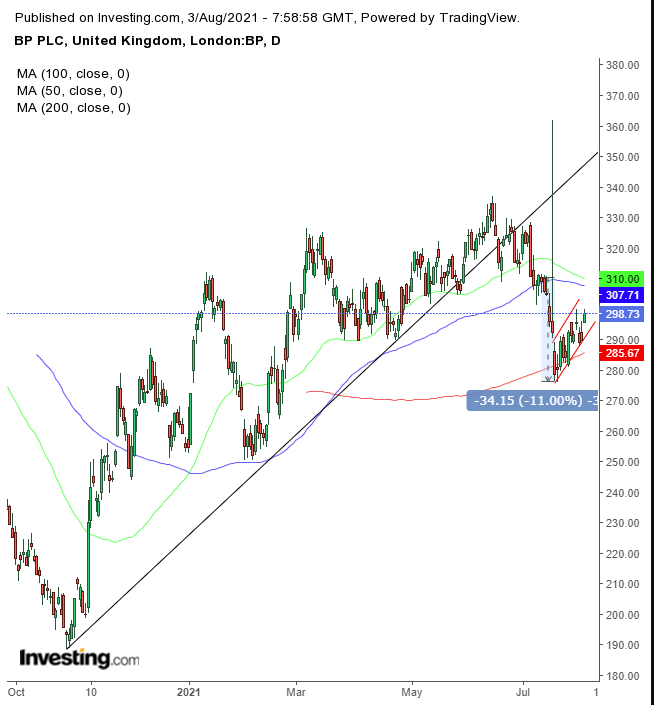
The current rally trades along a rising flag—presumed bearish after the preceding 11% plunge in 5 sessions, after having fallen below the uptrend line. The pattern is complete upon a decisive downside breakdown.
Despite the aforementioned quarterly gains for oil, crude held a decline amid the persistent spread of the coronavirus and signs of a muted Chinese recovery which hit demand.
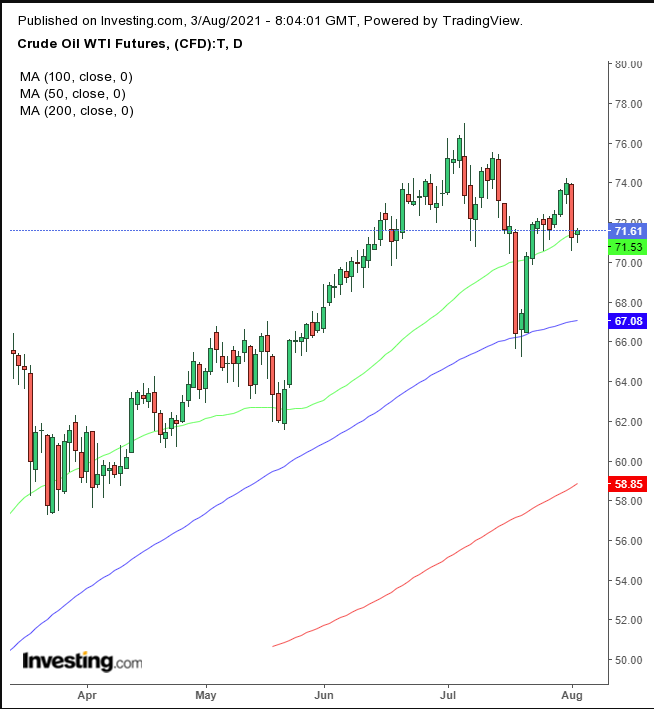
Monday’s 3.6% selloff of the commodity wiped away more than 4 days of progress, and the price has been struggling to find its footing above the 50 DMA. If oil continues lower, below the 100 DMA, then the July 20 low, which has provided support as an uptrend line, will have established a peak-trough downside formation for prices.
Earlier, Asian shares fell as the relentless spread of the Delta strain of COVID-19 increased in key markets. Monday's selloff on Wall Street did not help sentiment.
Japan’s Nikkei 225 and China’s Shanghai Composite both fell 0.5%, after Chinese media characterized online gaming as “spiritual opium,” though later it removed the report, as the government apparently wished not to exacerbate already nervous investors on regulatory clampdowns.
The New Zealand dollar rose on speculation of tightening policy, but technicals are signaling the NZD won't rally.
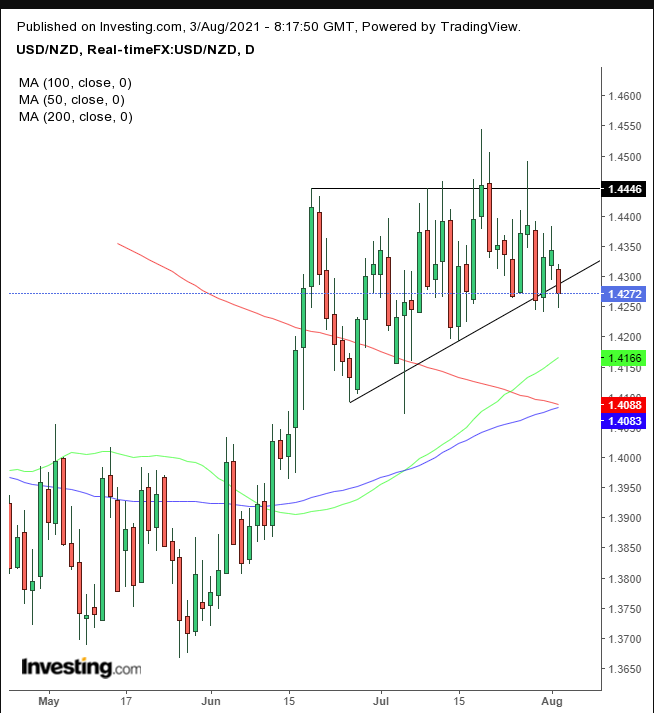
The US dollar has been rising against NZD within an ascending triangle, which, coupled with a Golden Cross, after the 50 DMA crossed above the 100 DMA, primes the greenback for an upside breakout and a continued rally against the New Zealand dollar.
The Australian dollar jumped too, after policymakers stayed true to their bond tapering plan despite the ongoing Delta-variant lockdown in Sydney.
But, again, supply-and-demand are geared to push the Aussie back down.
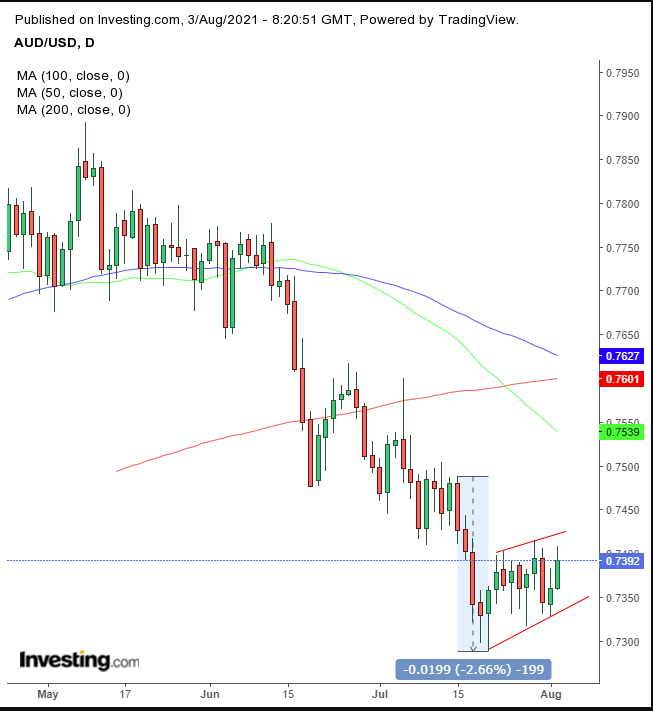
The AUD/USD pair appears to be trading within a rising flag, presumed bearish after a 2.7% plunge in four days. A downside breakout will confirm a continued downtrend, signaled by the death cross.
Yields on the 10-year Treasury note appeared to find their footing at 1.190, finding support at July lows, after closing yesterday at the lowest level since early February.

However, the impending Death Cross encapsulates the exponential drop in yields, as seen by the continuously faster falling channel. Moreover, real rates fell to a record low, as investors don’t expect rates to rise in the near future, after US manufacturing weakened, compounding fears that the virus will hurt the country’s expansion.
The dollar edged lower for the second day, ranging since last week’s four-day selloff.

The Golden Cross—as the 50 DMA crossed over the 100 DMA, demonstrating relatively improving pricing—supports the rally, which, if it moves above 94, would bottom. This would likely be on fresh hopes for that the strong economic recovery investors have been hoping for, would force the US Federal Reserve into policy tightening despite its current rhetoric.
Gold fell even though the dollar was weaker.
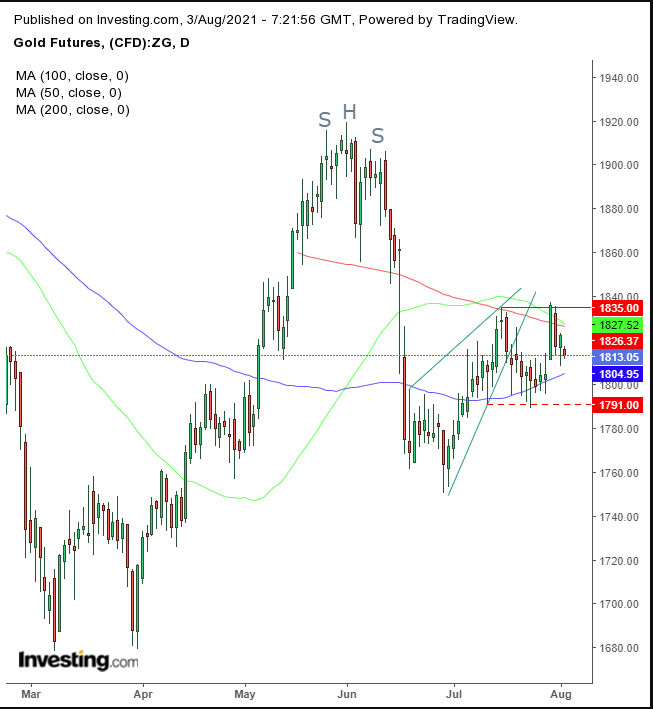
After completing a return move that successfully retested the bearish wedge, the price of the precious metal is primed to form a small double-top, which would send the yellow metal even lower.
Bitcoin sold off for the fourth straight day as the new US Securities and Exchange Commission Chairman, Gary Gensler, asked Congress to authorise him to monitor crypto exchanges. Gensler said he’s not a fan of the extremely volatile unregulated market, nor does he have any plans for a Bitcoin ETF.
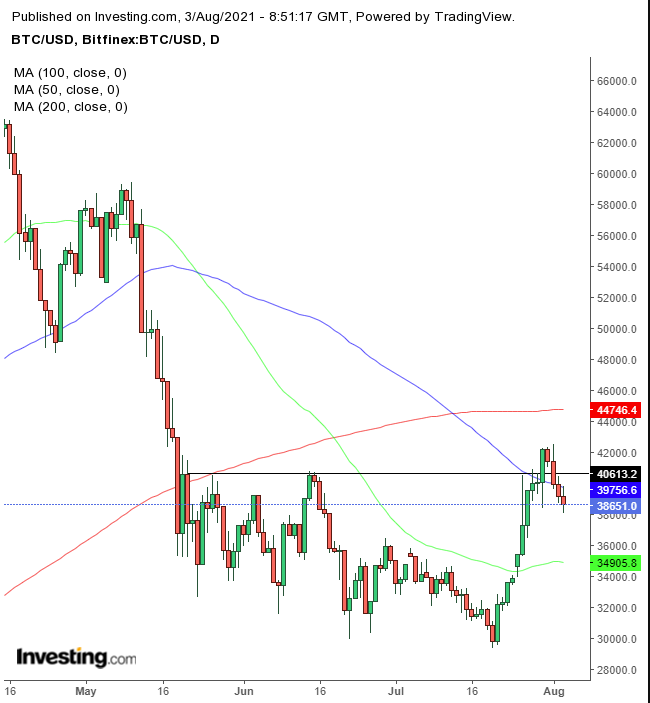
Bitcoin’s drop took its price back below the neckline of a would-be bottom, cutting through the 100 DMA—whose breeching was recently celebrated by the financial media. The digital token attempted to climb back above it, but was rejected.
